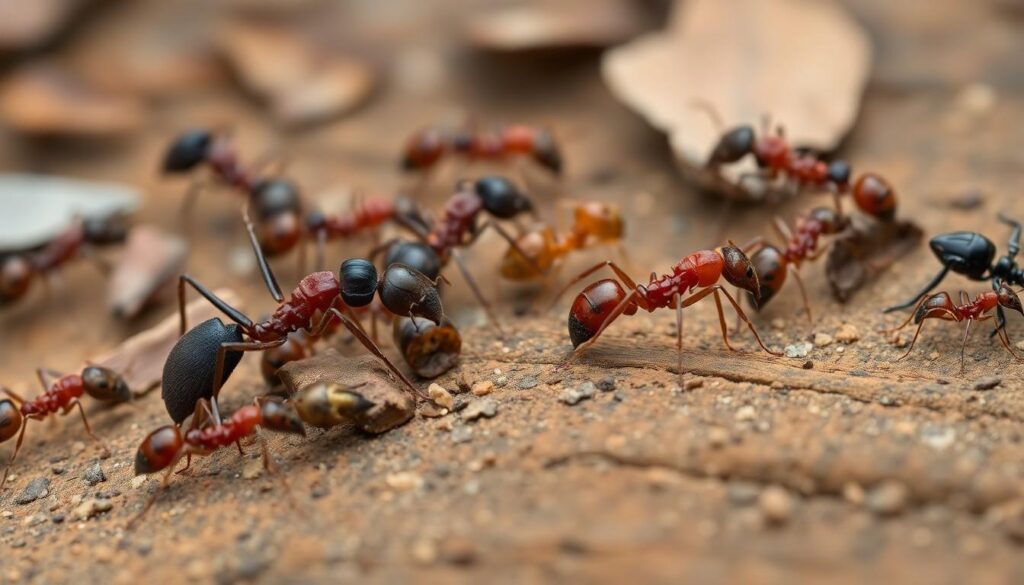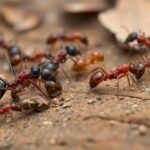Ever wondered about the intriguing area of ant names? We’ve compiled the ultimate guide to help you identify and understand these remarkable insects that live all around us. From scientific classifications to common nicknames, ant names reveal surprising insights about these tiny creatures.
We’ll explore how ants get their names based on appearance, behavior, and habitat. Whether you’re curious about carpenter ants destroying wood in your home or fire ants with their painful stings, understanding ant names is the first step to identifying which species you’re dealing with. Join us as we jump into the intricate naming systems entomologists use and discover why these tiny insects have earned such diverse and descriptive titles across cultures.
10 Fascinating Common Ant Names You Should Know
1. Carpenter Ants
Carpenter ants earned their name from their habit of excavating wood to build nests. These large black or red ants don’t actually eat wood like termites but remove it to create elaborate tunnel systems. You’ll often find them in damp or decaying wood around homes, particularly in areas with moisture issues such as bathrooms or kitchens. Their powerful jaws can cause important structural damage if left unchecked.
2. Fire Ants
Fire ants are notorious for their painful sting that creates a burning sensation similar to fire. These aggressive reddish brown insects inject venom containing alkaloids that cause raised welts and potential allergic reactions. Native to South America, they’ve invaded many warm regions including the southern United States. Their distinctive dome-shaped mounds can reach heights of 18 inches above ground.
3. Harvester Ants
Harvester ants get their name from their habit of collecting and storing seeds. These industrious creatures create large, bare areas around their nests by clearing vegetation, making them easy to spot in fields and grasslands. Many species have a powerful sting used for defense against predators. Their complex underground nests can extend several feet below the surface with multiple chambers for food storage.
4. Army Ants
Army ants earned their military moniker due to their coordinated group hunting behavior where thousands march together in search of prey. These nomadic ants don’t build permanent nests but form temporary bivouacs using their own bodies linked together. Their powerful mandibles can dismantle small vertebrates and insects with shocking efficiency. Colonies can contain millions of individuals moving as a single destructive force.
5. Leafcutter Ants
Leafcutter ants are named for their remarkable behavior of cutting and carrying leaf fragments many times their size. These gardening experts don’t actually eat the leaves but use them to cultivate fungus underground, which serves as their primary food source. Their complex societies include specialized worker castes, each with exact responsibilities. A mature colony can harvest over 500 pounds of leaves annually.
6. Bullet Ants
Bullet ants have earned their intimidating name from their sting, which feels like being shot with a bullet. Found in rainforest regions of Central and South America, these inch-long black ants inflict what’s considered the most painful insect sting in the industry. The intense pain can last for up to 24 hours, accompanied by trembling, sweating, and nausea. Some indigenous tribes use these ants in manhood initiation ceremonies.
7. Weaver Ants
Weaver ants are named for their extraordinary nest-building technique using larval silk to weave leaves together. These skilled architects create elaborate aerial nests throughout tropical forest canopies in Africa, Asia, and Australia. Their colonies can span multiple trees with several satellite nests connected by ant highways. Workers form living chains to pull leaves together during construction.
8. Honey Pot Ants
Honey pot ants feature specialized workers called repletes that store liquid food in their greatly distended abdomens. These living storage vessels hang from chamber ceilings in the nest, serving as living larders during food shortages. Their abdomen can swell to the size of a small grape, filled with a sweet honey-like substance. Indigenous people in Australia and North America have traditionally harvested these ants as a sweet treat.
9. Velvet Ants
Velvet ants aren’t actually ants at all but wingless female wasps covered in dense, colorful velvet-like hair. Their striking appearance serves as a warning to predators about their extremely painful sting, earning them the alternative name “cow killer.” Most species are solitary parasites that lay eggs in the nests of ground-dwelling bees and wasps. Their thick exoskeleton provides protection from potential hosts.
10. Driver Ants
Driver ants got their name because they “drive” away everything in their path during massive foraging expeditions. These African relatives of army ants form temporary swarm raids with millions of individuals searching for food. Their powerful jaws can dismantle creatures much larger than themselves through sheer numbers and coordination. Locals must sometimes evacuate their homes when these unstoppable columns approach.
Understanding the Taxonomy of Ant Names

To truly appreciate the intriguing area of ants, we need to understand how they’re classified and named in scientific communities. Ant taxonomy follows a structured system that helps researchers categorize these incredible insects while maintaining clarity across different languages and regions.
Scientific Classification System
Ants belong to the family Formicidae, which fits within a precise taxonomic hierarchy starting from the domain Eukaryota down to the exact family level. The complete classification places ants in the kingdom Animalia, phylum Arthropoda, class Insecta, order Hymenoptera, infraorder Aculeata, and superfamily Formicoidea. Within the Formicidae family, scientists have identified 17 distinct subfamilies containing approximately 334 genera. Currently, over 13,800 ant species have been documented, though researchers estimate the actual number could reach around 22,000 species worldwide. This highly organized system allows entomologists to categorize new discoveries and understand evolutionary relationships between different ant groups.
Common Names vs. Scientific Names
Common names serve as everyday identifiers for ants based on their distinctive characteristics or behaviors. Fire ants earned their name from their painful stings, while army ants are known for their coordinated hunting patterns. Trap-jaw ants possess lightning-fast mandibles, and turtle ants have unique shield-like head structures. Other descriptive common names include fungus-growing ants, exploding ants, and socially parasitic ants. These informal names help non-scientists identify and discuss ant species, but they often vary by region and language.
Scientific names follow the standardized Linnaean binomial nomenclature system, consisting of both genus and species components that appear in italics. Formica rufa (the red wood ant) represents the type species for the entire Formicidae family, while Solenopsis invicta identifies the red imported fire ant. These Latin-based scientific names remain consistent worldwide, enabling researchers across different countries to communicate about exact ant species without confusion or ambiguity. The taxonomic hierarchy provides increasing specificity from family (Formicidae) to subfamily (such as Ponerinae or Myrmicinae) to genus (like Formica or Camponotus) and finally to individual species.
Most Popular Carpenter Ant Names Around the World

Carpenter ants are renowned for their wood-boring activities and are found in various regions across the globe. These industrious insects have distinct species names that often reflect their geographic location or physical characteristics.
North American Carpenter Ants
The Black Carpenter Ant (Camponotus pennsylvanicus) dominates the eastern United States, particularly in Ohio, and is commonly known as the Eastern carpenter ant or Big Black Carpenter ant. Its imposing size and dark coloration make it easily identifiable among other ant species.
The Western Carpenter Ant (Camponotus modoc) thrives throughout western North America, establishing colonies in both urban and forested environments. Meanwhile, the Desert Carpenter Ant (Camponotus vicinus) has adapted to survive in the harsh arid regions of North America.
Smaller species also populate the continent, including Camponotus nearcticus (Southern small carpenter ant) and Camponotus subbarbatus (Northern small carpenter ant). Florida and other southern regions are home to the Florida Carpenter Ant (Camponotus floridanus), which prefers the warmer climate and abundant wooden structures found in these areas.
European Carpenter Species
Europe boasts several notable carpenter ant species, with the Hercules Ant (Camponotus herculeanus) being particularly widespread across both European and North American territories. This remarkable species demonstrates impressive strength relative to its size.
Camponotus ligniperda commands attention as a common European species, recognized for its persistent wood-boring activities that can damage wooden structures. Another prevalent European species is Camponotus vagus, which establishes colonies in various habitats throughout the continent.
Beyond North America and Europe, other notable species include the Japanese Carpenter Ant (Camponotus japonicus) found throughout Japan, and the Tacuru Ant (Camponotus punctulatus), which creates distinctive nests in certain regions. Each species has evolved unique adaptations suited to their native environments while maintaining the characteristic wood-excavating behavior that defines carpenter ants.
Fire Ant Names That Signal Danger

When you hear these names, be warned—they indicate ants capable of delivering painful stings and exhibiting aggressive behavior. Fire ants have earned exact monikers that highlight their dangerous nature.
Red Imported Fire Ant
The Red Imported Fire Ant (Solenopsis invicta) represents one of the most notorious and invasive fire ant species in the United States. Originally from South America, this species earned its name due to its distinctive reddish-brown coloration and the fact that it was introduced to the U.S. rather than being native. These aggressive insects have spread extensively throughout southern states, causing ecological disruption and posing health risks to humans and animals alike. Their painful stings can cause intense burning sensations, followed by pustules that develop on the skin—a characteristic that contributed significantly to their “fire” designation.
Native Fire Ant Species
America’s native fire ant population includes several noteworthy species that also carry warning names. The Tropical Fire Ant (Solenopsis geminata), also referred to as the “Black Imported Fire Ant,” exists naturally in U.S. ecosystems and delivers similarly painful stings. Another important native species is Solenopsis xyloni, commonly known as the “Southern Fire Ant,” which inhabits the southern United States. These native species, while sometimes overshadowed by their imported cousin, still command respect for their defensive capabilities. Some regions also use the term “Ginger Ants” to describe fire ants, referencing their distinctive reddish coloration that serves as a visual warning of their potentially painful sting.
Harvester Ant Names and Characteristics

Harvester ants stand out among the ant industry for their unique seed-collecting behavior and distinctive physical traits. These industrious insects play crucial roles in their ecosystems through their specialized foraging techniques.
Scientific Names and Genera
Harvester ants primarily belong to the genus Pogonomyrmex, which encompasses many species specialized in seed collection and storage. These ants have evolved exact adaptations that make them exceptionally efficient at harvesting seeds from their surroundings. Many Pogonomyrmex species share similar characteristics while maintaining unique traits that help researchers distinguish between them. Their classification reflects their specialized ecological niche as seed harvesters in arid environments.
Red Harvester Ants
Red Harvester Ants (Pogonomyrmex barbatus) represent one of the most recognizable harvester ant species in North America. These ants measure approximately 5-7 mm in length and display a distinctive reddish-brown coloration that makes them easily identifiable. Workers feature powerful mandibles designed specifically for cutting and carrying seeds back to their colony. Brushy hairs on the front of their heads serve as essential tools that aid in gathering and transporting various materials to their nests. Red Harvester ants construct elaborate underground colonies that can persist for years or even decades in suitable habitats.
Agricultural Harvester Species
Several harvester ant species demonstrate remarkable agricultural-like behaviors that have earned them recognition among entomologists. Western Harvester Ants (Pogonomyrmex occidentalis) exhibit a reddish-brown appearance and thrive primarily in open grasslands throughout the eastern Plains and San Luis Valley of Colorado. Rough Harvester Ants (Pogonomyrmex rugulosus) feature a distinctive color pattern with black heads and thoraxes contrasting against reddish-brown bodies. These particular ants have a more limited distribution, occurring mainly in southeastern Colorado.
Harvester ants communicate through complex chemical signals, using pheromones to coordinate activities among colony members. Their highly organized social structure assigns exact roles to different individuals within the colony. Workers range from 1/4 to 1/2 inches in length and use powerful mandibles to harvest and process seeds. Most harvester ant species prefer arid regions and open grasslands where seed resources are abundant and accessible.
Army Ant Names That Strike Fear

Army ants aren’t a single taxonomic group but rather represent several species sharing aggressive, coordinated foraging behaviors. These formidable insects have earned some equally intimidating names across different regions and languages.
Driver Ant Names
Driver ants belong to the fearsome category of Old Industry army ants, primarily represented by the genus Dorylus. These insects earned their name from their ability to literally “drive” other animals from their path during massive raids. Commonly found throughout Africa, driver ants form some of the largest colonies in the ant industry, sometimes containing over 20 million individuals. Their overwhelming numbers and coordinated hunting techniques make them formidable predators that can subdue prey many times their size. Local communities often refer to them as “siafu” in parts of East Africa, a name that commands immediate respect due to their painful bites and overwhelming swarm tactics.
Eciton Burchellii: The Infamous Army Ant
Eciton burchellii stands as perhaps the most notorious army ant species in the industry. Found throughout the Neotropics from southern Mexico to northern Argentina, these New Industry army ants have become the poster species for army ant behavior. Their massive daytime raids featuring hundreds of thousands of workers moving in coordinated columns have captivated researchers and nature enthusiasts alike. Unlike many army ant species that forage primarily underground, Eciton burchellii conducts visible above-ground raids, making them particularly well-studied by entomologists. Their nomadic lifestyle involves alternating between stationary phases (when the queen lays eggs) and migratory phases (when the colony relocates daily). Another noteworthy relative, Eciton hamatum, shares similar behaviors but features distinct physical characteristics that set it apart from its infamous cousin.
Unique Ant Names Based on Appearance

Many ant species have earned distinctive names based on their physical features and behaviors. These appearance-based names often provide clues about the ant’s physical traits, habitats, or notable characteristics.
Bulldog Ants
Bulldog ants earned their name from their powerful mandibles and aggressive stance, reminiscent of the tenacious canine breed. These imposing insects, primarily found throughout Australia, are known for their robust bodies and intimidating presence. Their strong jaws contribute to their fearsome reputation, as they can deliver one of the most painful stings in the ant industry. Bulldog ants possess exceptional vision with their large eyes, allowing them to track prey and potential threats with remarkable precision. They’re also referred to as “jack jumper ants” due to their ability to leap short distances when threatened or hunting.
Gliding Ant Species
Gliding ants have developed remarkable adaptations that allow them to navigate through the air between trees in tropical forests. Twig ants represent a fascinating subgroup with wasp-like elongated bodies and distinctive oval-shaped eyes that assist in their aerial navigation. Their dark brown-black or orange-brown coloration helps them blend into forest environments when not in flight. Human encounters with these specialized ants often result in painful stings, particularly when their nests in thick bushes are disturbed.
The genus Cephalotes contains several notable gliding ant species named for their unique head shapes and impressive aerial abilities. These specialized ants have evolved flattened bodies that function as natural gliders, allowing them to control their descent when falling from trees. Rather than plummeting directly to the forest floor, these skilled gliders can steer themselves back toward the tree trunk, avoiding both ground predators and the need to make a lengthy journey back up to their arboreal nests.
Other appearance-based ant names include Blaze for ants with fiery attitudes, Titan for particularly powerful specimens, and Nova for standout individuals. Names like Spike reflect sharp physical features, while Vortex and Cyclone describe ants constantly in motion. Female ants often receive gentler names such as Petal, Sprout, and Twinkle that highlight their more delicate features while maintaining their important roles in the colony.
Medicinal and Culinary Ant Names

Certain ant species offer more than just ecological benefits, serving as food sources and traditional remedies in various cultures around the industry.
Honeypot Ants
Honeypot ants, scientifically classified under the genus Myrmecocystus, have evolved a fascinating biological adaptation that gives them their distinctive name. These remarkable insects designate exact worker ants as living storage vessels, with these “honeypots” consuming nectar and honeydew until their abdomens become greatly engorged with sweet liquid. When food becomes scarce, these specialized ants regurgitate their stored nutrients to feed other colony members. Honeypot ants inhabit arid and semi-arid environments across every continent except Antarctica, where they’ve adapted to harsh conditions by developing this unique food storage system. Their diet primarily consists of nectar, honeydew from aphids, and protein from other insects. While not widely used in formal medicine, the sweet liquid stored in honeypot ants serves as a natural sugar source in some indigenous cultures, particularly in Australia and North America.
Leafcutter Ant Varieties
Leafcutter ants, belonging to the genera Atta and Acromyrmex, represent some of the most sophisticated farmers in the insect industry. Notable species include Atta cephalotes, known for establishing massive colonies, Atta laevigata with its distinctive large-headed soldiers, and Acromyrmex octospinosus found throughout Central and South America. Unlike most ants, leafcutters don’t directly consume the leaves they meticulously harvest; instead, they use this vegetation to cultivate a specialized fungus that serves as their primary food source. In several Latin American countries, these ants hold important culinary value, with both adult ants and their larvae being consumed fried or roasted as protein-rich delicacies. Culinary enthusiasts describe their flavor profile as distinctly buttery and nutty, making them a sought-after ingredient in traditional dishes. The protein content in leafcutter ants exceeds that of many conventional meat sources, highlighting their nutritional value even though their small size.
Bizarre Ant Names With Interesting Origins

In the intriguing area of myrmecology, some ant species have acquired names that are as extraordinary as their characteristics. These bizarre names often reflect unique behaviors, appearance, or discovery circumstances that make these ants stand out in the insect kingdom.
Exploding Ants
Exploding ants, scientifically known as ants in the genus Colobopsis, particularly Colobopsis explodens, possess one of the most extreme defense mechanisms in nature. These remarkable insects can deliberately rupture their own bodies when threatened, releasing a sticky, toxic substance that deters predators. Scientists refer to this dramatic self-sacrificing behavior as “autothysis,” where worker ants essentially turn their bodies into chemical weapons for colony defense. Found primarily in Southeast Asian forests, these ants demonstrate how evolution has created astonishing survival strategies that inspired their explosive namesake.
Dracula Ant Species
The Dracula ant, belonging to the genus Amblyoponinae, earned its vampiric name from its truly bizarre feeding habits. These mysterious ants pierce the bodies of insect prey or even their own larvae to feed on hemolymph (insect blood), similar to how the fictional Count Dracula fed on human blood. Their predatory behavior includes a unique form of nourishment called “non-destructive cannibalism,” where adult ants feed on the hemolymph of their own larvae without killing them. Scientists have identified many species within this group, making them one of the most peculiar examples of how feeding behaviors can inspire colorful and memorable ant names.
Yellow Crazy Ants
Yellow crazy ants (Anoplolepis gracilipes) earned their distinctive name due to their frenetic, erratic movement patterns and bright yellow coloration. These invasive insects move in chaotic, unpredictable paths when disturbed, creating the impression of “craziness” to human observers. Their rapid, jerky movements combined with aggressive territorial behavior have made them notorious ecological invaders in many regions worldwide. Originally native to Africa, these ants have spread to many tropical and subtropical ecosystems, causing important environmental damage through their ability to form super colonies with multiple queens.
Martialis heureka
Martialis heureka, discovered in the Amazon rainforest, boasts perhaps one of the most otherworldly names in the ant kingdom. Translating roughly to “ant from Mars, eureka!” this species earned its name due to its bizarre, alien-like appearance. Lacking eyes completely and featuring long, fang-like mouthparts, these pale, subterranean hunters look so unusual that scientists joked they seemed to have arrived from another planet. Their discovery was important enough to warrant creating an entirely new subfamily – the first new living ant subfamily identified since 1923. This remarkable species demonstrates how truly odd evolutionary adaptations can inspire imaginative scientific naming.
Eurhopalothrix
Ants in the genus Eurhopalothrix showcase how ancient mythology and cultural references influence scientific naming practices. Entomologist Jack Longino named several species after Mayan lords and demons, reflecting their fierce appearance under microscopic examination. These tiny predators feature broad facial shields, reduced eyes, and sharp, menacing teeth that give them a formidable look even though their small size. The genus name itself refers to the distinctive club-shaped hairs found on many species within this group. These specialized hunters demonstrate how microscopic features can inspire names that connect to historical and mythological traditions.
How Scientists Name New Ant Species

Scientists follow exact conventions when naming new ant species, creating a systematic approach to classification that helps researchers worldwide identify and study these fascinating insects.
Naming Conventions in Myrmecology
Myrmecology, the scientific study of ants, follows strict naming protocols that maintain consistency across the field. All ant species receive a binomial scientific name consisting of two parts: the genus name (always capitalized) and the species name (always lowercase). For example, in Camponotus novaeboracensis, “Camponotus” represents the genus while “novaeboracensis” indicates the exact species within that genus. These scientific names typically derive from Greek or Latin roots that describe notable characteristics of the ant. The name Camponotus comes from Greek meaning “bent-back,” while novaeboracensis is Latin for “of New York,” indicating where this particular species was discovered or is commonly found. When scientists identify a new ant species, they must prove its uniqueness, provide a detailed description, and publish their findings in a scientific journal to officially establish the name.
Famous Entomologists and Their Namesake Ants
Many prominent entomologists have been honored by having ant species named after them, recognizing their contributions to the field. Carl Linnaeus, though not exclusively an ant researcher, established the binomial nomenclature system that forms the foundation of all biological classification. Pierre André Latreille, a distinguished French entomologist, described many ant species and received recognition through the superfamily name Formicoidea Latreille, 1809. William Morton Wheeler stands as one of the most influential myrmecologists in history, having described countless ant species throughout his career. Several ant species now bear Wheeler’s name as a testament to his groundbreaking research in ant biology and behavior. These namesake species serve not only as scientific classifications but also as lasting tributes to researchers who dedicated their lives to understanding these complex social insects.
Why Understanding Ant Names Matters for Identification
Ant names serve as our gateway to understanding the incredible diversity of these remarkable insects. From the wood-excavating carpenter ants to the fiery tempered fire ants each name reveals something essential about their behavior habits or appearance.
Whether it’s the agricultural harvester ants or the coordinated army ants these names aren’t just labels but keys to identification. They reflect evolutionary adaptations and ecological roles that have developed over millions of years.
We’ve seen how names can indicate danger (fire ants) signal unique abilities (gliding ants) or highlight bizarre behaviors (exploding ants). By understanding these naming conventions we’re better equipped to identify appreciate and coexist with the thousands of ant species that shape our ecosystems worldwide.
Frequently Asked Questions
Why do ants have different names?
Ants have different names based on their appearance, behavior, habitat, and other distinctive characteristics. Scientists use a structured classification system (taxonomy) to identify over 13,800 documented ant species. Common names like carpenter ants, fire ants, and harvester ants reflect their notable traits, while scientific names follow the standardized Linnaean binomial nomenclature system to ensure global consistency in identification.
What are carpenter ants and why are they called that?
Carpenter ants earned their name from their habit of excavating wood to build nests. Unlike termites, they don’t eat wood but remove it to create tunnels and chambers. Notable species include the Black Carpenter Ant (Camponotus pennsylvanicus) in North America and the Hercules Ant (Camponotus herculeanus) in Europe. Their wood-boring behavior can sometimes cause structural damage to buildings.
Why are fire ants considered dangerous?
Fire ants earned their name from their painful stings that cause a burning sensation. The Red Imported Fire Ant (Solenopsis invicta) is particularly notorious as an invasive species in the U.S. These aggressive ants deliver venom that can cause intense pain, swelling, and allergic reactions in some people. Their distinctive reddish-brown coloration serves as a warning signal of their defensive capabilities.
What makes harvester ants unique?
Harvester ants are seed collectors that gather, store, and consume seeds as their primary food source. Primarily belonging to the genus Pogonomyrmex, species like the Red Harvester Ant (Pogonomyrmex barbatus) have powerful mandibles for cracking seeds. They create distinctive nest entrances surrounded by cleared areas and exhibit complex agricultural-like behaviors including seed processing and storage techniques.
What are army ants and how do they behave?
Army ants aren’t a single species but several groups known for their coordinated mass foraging raids. Species like Eciton burchellii conduct massive daytime raids with millions of workers forming living bridges and chains. These nomadic ants don’t build permanent nests but instead form temporary bivouacs using their own bodies. Their coordinated hunting strategy allows them to overwhelm prey much larger than individual ants.
Are there ants with unusual defensive mechanisms?
Yes, some ants have extraordinary defenses. Exploding ants (Colobopsis explodens) can rupture their abdomens as a last-resort defense mechanism, releasing sticky, toxic substances onto enemies. Gliding ants can control their descent when falling from trees. Bullet ants deliver one of the most painful insect stings in the world, while Dracula ants use a unique spring-loaded mandible system to strike at incredible speeds.
Can people eat ants?
Yes, several ant species are consumed in cultures worldwide. Honeypot ants, with their sweet nectar-filled abdomens, are considered delicacies in parts of Australia and North America. Leafcutter ants are eaten in countries like Colombia and Mexico, where they’re toasted and have a nutty flavor. Ants generally provide a good source of protein and various nutrients, making them a sustainable food option in many regions.
How do scientists name new ant species?
Scientists follow strict conventions when naming new ant species, adhering to the binomial nomenclature system established by Carl Linnaeus. Each species receives a two-part Latin or Greek name indicating its genus and species. Names often reflect the ant’s appearance, behavior, habitat, or honor a person or place. All new species names must be published in scientific journals with detailed descriptions to be officially recognized.
What is the difference between common and scientific ant names?
Common ant names (like fire ant or carpenter ant) are informal, descriptive, and vary by region and language. They typically reflect observable traits but may refer to multiple species. Scientific names follow the standardized two-part Linnaean system (genus and species) in Latin or Greek. Unlike common names, scientific names are unique, universally recognized regardless of language, and precisely identify specific ant species.
What is the most unusual ant name and why?
Martialis heureka (“ant from Mars”) holds one of the most unusual scientific names, given because its bizarre appearance and primitive characteristics made it seem alien when discovered in 2000. Other contenders include Eurhopalothrix, named after Mayan mythology, and Paraponera clavata (bullet ant), named for its sting that feels like being shot. The recently discovered Colobopsis explodens earned its descriptive name from its self-destructive defense mechanism.







